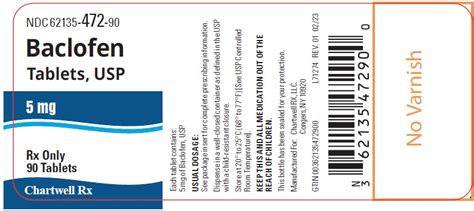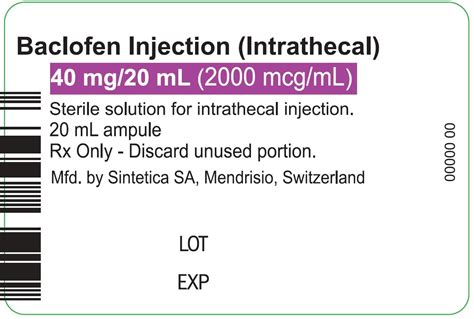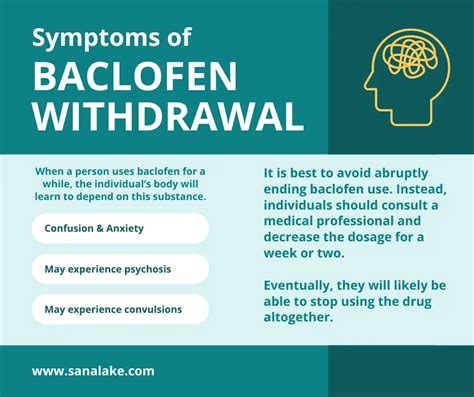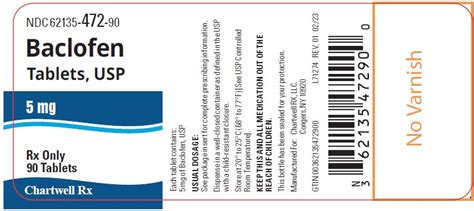Intro
Discover key baclofen facts, including its uses, side effects, and interactions, to understand this muscle relaxants role in managing spasticity, multiple sclerosis, and other conditions, with insights into dosage, benefits, and risks.
Baclofen is a medication that has been widely used for several decades to treat various conditions, particularly those related to muscle spasms and neurological disorders. Despite its common use, there are many aspects of baclofen that patients and even some healthcare professionals may not be fully aware of. Understanding the intricacies of baclofen, including its mechanism of action, side effects, and potential uses beyond its primary indications, can provide valuable insights into its role in modern medicine.
The importance of baclofen lies in its ability to manage symptoms that significantly impact the quality of life for many individuals. Muscle spasms, for instance, can be debilitating, causing pain and limiting mobility. Baclofen's efficacy in alleviating these symptoms has made it a cornerstone in the treatment of conditions like multiple sclerosis and spinal cord injuries. However, its application extends beyond these areas, highlighting the need for a comprehensive understanding of this medication.
As research and clinical experience with baclofen continue to grow, so does our understanding of its potential benefits and risks. This knowledge is crucial for optimizing treatment outcomes and ensuring patient safety. By exploring the various facets of baclofen, including its pharmacology, clinical uses, and safety profile, healthcare providers can make more informed decisions regarding its use. Moreover, patients can better understand what to expect from treatment and how to manage any side effects that may arise.
Introduction to Baclofen

Baclofen is a central nervous system depressant that acts as a gamma-aminobutyric acid (GABA) receptor agonist. Its primary mechanism of action involves the stimulation of GABA_B receptors, which are metabotropic receptors that decrease neuronal excitability throughout the nervous system. This action results in the alleviation of muscle spasticity, which is characterized by an abnormal increase in muscle tone. By reducing muscle spasms, baclofen improves mobility and reduces the discomfort associated with spasticity.
Pharmacokinetics and Pharmacodynamics
The pharmacokinetics of baclofen involve its absorption, distribution, metabolism, and excretion. After oral administration, baclofen is rapidly absorbed, with peak plasma concentrations occurring within 1-3 hours. It is distributed throughout the body, crossing the blood-brain barrier to exert its central effects. Baclofen is metabolized minimally and is primarily excreted unchanged in the urine, which means its clearance is largely dependent on renal function.Clinical Uses of Baclofen

Baclofen is primarily indicated for the treatment of spasticity, which can result from a variety of conditions, including multiple sclerosis, spinal cord injuries, and cerebral palsy. Its use in these conditions is aimed at reducing muscle spasms, improving mobility, and enhancing the patient's ability to perform daily activities. Beyond its approved indications, baclofen has been explored for several off-label uses, including the management of hiccups, trigeminal neuralgia, and even as an adjunct in the treatment of alcohol dependence and withdrawal.
Benefits and Risks
The benefits of baclofen in managing spasticity are well-documented, with significant reductions in muscle spasms and improvements in functional abilities reported in clinical trials. However, like all medications, baclofen is associated with potential side effects, some of which can be severe. Common side effects include drowsiness, dizziness, weakness, and nausea. More serious adverse effects, such as seizures and hallucinations, can occur, especially in the context of abrupt withdrawal or overdose.Administration and Dosage

Baclofen is typically administered orally, with tablets available in various strengths. The dosage of baclofen must be individualized, starting with a low dose that is gradually increased until the desired therapeutic effect is achieved or side effects limit further increases. The maintenance dose for spasticity usually ranges from 40 to 80 mg daily, divided into 3-4 doses. It is crucial to titrate the dose slowly to minimize the risk of adverse effects and to monitor patients closely for signs of toxicity or withdrawal.
Special Considerations
Special consideration must be given to certain patient populations, including the elderly, those with renal impairment, and pregnant or breastfeeding women. Baclofen's safety profile in these groups may differ, necessitating dose adjustments or careful monitoring. For instance, baclofen is excreted primarily by the kidneys, so its accumulation can occur in patients with impaired renal function, increasing the risk of adverse effects.Withdrawal and Dependence

One of the significant concerns with long-term baclofen use is the potential for dependence and the risk of withdrawal syndrome upon cessation. Withdrawal from baclofen can lead to severe and potentially life-threatening symptoms, including seizures, hallucinations, and rebound spasticity. The risk of withdrawal highlights the importance of gradual tapering of the dose when discontinuing baclofen, under the guidance of a healthcare provider.
Management of Withdrawal
The management of baclofen withdrawal involves a gradual reduction in dosage over a period of time, which can vary depending on the duration of use and the dose. In some cases, hospitalization may be necessary to manage withdrawal safely, especially if the patient is at risk of severe symptoms. Supportive care, including the use of other medications to control symptoms, may also be required.Future Directions and Research

Ongoing research into baclofen and its analogs may uncover new therapeutic applications and improve our understanding of its pharmacology. The development of novel GABA_B receptor agonists with potentially improved safety profiles or more targeted therapeutic effects is an area of active investigation. Additionally, the exploration of baclofen's use in combination with other medications may lead to enhanced efficacy or reduced side effects in the treatment of spasticity and other conditions.
Conclusion and Final Thoughts
In conclusion, baclofen is a valuable medication in the management of spasticity and has potential applications beyond its primary indications. Its use, however, requires careful consideration of its benefits and risks, as well as awareness of its potential for dependence and withdrawal. As our understanding of baclofen and its mechanisms of action continues to evolve, so too will its role in clinical practice. Healthcare providers and patients alike must remain informed about the latest developments and guidelines regarding baclofen to ensure its safe and effective use.What is the primary mechanism of action of baclofen?
+Baclofen acts as a gamma-aminobutyric acid (GABA) receptor agonist, specifically stimulating GABA_B receptors to decrease neuronal excitability and alleviate muscle spasticity.
What are the common side effects of baclofen?
+Common side effects include drowsiness, dizziness, weakness, and nausea. More severe side effects can occur, especially with abrupt withdrawal or overdose, and include seizures and hallucinations.
How should baclofen be discontinued to avoid withdrawal symptoms?
+Baclofen should be tapered gradually under the guidance of a healthcare provider to minimize the risk of withdrawal symptoms. The rate of tapering may vary based on the duration of use and the dose.
We invite readers to share their experiences or ask questions about baclofen in the comments below. This can help foster a community of support and provide valuable insights for those considering or currently using this medication. Additionally, sharing this article with others who may benefit from its information can contribute to a broader understanding of baclofen and its role in managing spasticity and other conditions.
